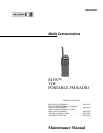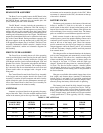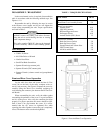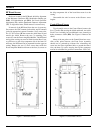
• Programmable Multi-Tone Channel Guard
(CTCSS) - Channel Guard tone frequencies within
the range of 67 Hz to 210.7 Hz, including all of the
standard EIA frequencies, can be programmed for
encoded/decoded operation.
• Programmable Multi-Code Digital Channel
Guard - Similar capability as with tone Channel
Guard is provided.
• Two-Tone Sequential (T99) Decode - Selective
calling decode is enabled or disabled on each
individual channel. Two (2) sets of unique de-codes
are programmable to allow large systems individual
and group call capability. Sets are selectable on a
mode (bank of channels) basis.
• Channel Busy Lockout - Personality information
includes transmit disable capability on a channel
where carrier activity is present This feature is
selectable on a per channel basis.
• GE-STAR Compatibility - The radio can be
programmed to transmit GE-STAR at PTT key, at
PTT unkey, or both. 16,384 individual ID codes are
available.
• Emergency Signalling Feature - GE-STAR
emergency signalling can be enabled by the red
Emergency/Home Button on the top of the radio or it
can be enabled by a lanyard connected to the UDC.
• Home Button - The radio can be programmed to
switch to a home mode or channel (depending on
Control Knob’s programming) when the red
Emergency/Home Button on the top of the radio is
pressed.
• Programmable Carrier Control Timer - A
programmable transmit timer will automatically
disable the transmitter and provide an alerting tone
after time-out. This feature prevents radio damage and
unnecessary channel traffic in the event of a "stuck"
mic. The CCT is reset on every PTT.
• Programmable Transmit Power Level - Transmitter
power level is PC programmable into the radio (high
or low) on a per channel basis.
• Squelch Tail Elimination - Squelch and audio
circuits are designed so that annoying squelch pops
which may occur at the end of received messages are
minimized. This feature is compatible with existing
STE systems.
• Alert Tones - Alert tones prompt the operator of
various radio conditions such as key pressed, CCT
time-out or a low battery.
• Power-Up Self-Test - At power-up the radio
automatically performs a diagnostic test on itself and
reports any found errors via the LCD.
• Programmable via the Universal Device Connector
(UDC) - The entire operation of the radio can be field
customized by programming the unit using an IBM
PC or compatible computer. The programmed
personality is stored in nonvolatile memory within the
radio.
• Simple Remote Control Capability - External
accessories can be connected to the UDC such as a
headset, a speaker-mic or a lanyard. Connection of
the speaker-mic allows the operator to remotely
control PTT operation and audio level of the external
speaker. An antenna jack is located on the UDC for
the connection of a remote mounted antenna such as
when the radio is used in a vehicular charger.
• Meets MIL-810C and D Specifications - The sturdy
die-cast aluminum case is designed to seal out
moisture, blowing rain and other harsh environmental
factors.
• Battery Packs - Several different battery pack sizes
and capacities are available.
• Available Options - These options include the
antennas, audio accessories, batteries, carrying
accessories, chargers, lanyards, and the vehicular
chargers.
DESCRIPTION
Two major assemblies form an M-PA radio. The Front
Cover Assembly contains all of the microprocessor circuitry,
audio circuitry and the operating controls. The Rear Cover
Assembly houses the RF circuitry which includes the trans-
mitter, receiver and the frequency synthesizer. The assem-
blies are electrically interconnected by two single-in-line
type connectors. When mated together, the assemblies form
a weather resistant diecast aluminum case that protects the
radio’s circuitry from harsh outside environments.
Power is provided by a battery pack that slides and
locks on to the bottom of the radio. The radio’s on/off
switch is located on the battery pack.
The antenna screws on to the top of the unit A side an-
tenna connection is also provided at the UDC for an external
antenna or for test purposes. This UDC antenna connection
is also utilized for external antenna operation when the radio
is locked in the vehicular charger.
LBI-38378
6


















